PADM-3500 - China Tariffs: Effects on US Startups & Small Businesses
VerifiedAdded on 2023/05/28
|9
|2403
|74
Report
AI Summary
This report examines the proposed tariffs on China and their effects on small businesses. It introduces the topic, reviews relevant literature, and presents a financial analysis of the tariffs' impact. The literature review highlights the potential for unintended consequences, such as increased costs for bakeries and economic fluctuations. The financial analysis discusses how tariffs can lead to higher prices for consumers and increased financial burdens for small businesses, potentially leading to economic decline. The report concludes that tariffs can negatively affect small businesses and consumers and suggests implementing appropriate regulations and ethical considerations to mitigate these effects. It emphasizes the need for government and senior officials to address tariff issues, involve consumers, and conduct thorough economic analyses before implementation.
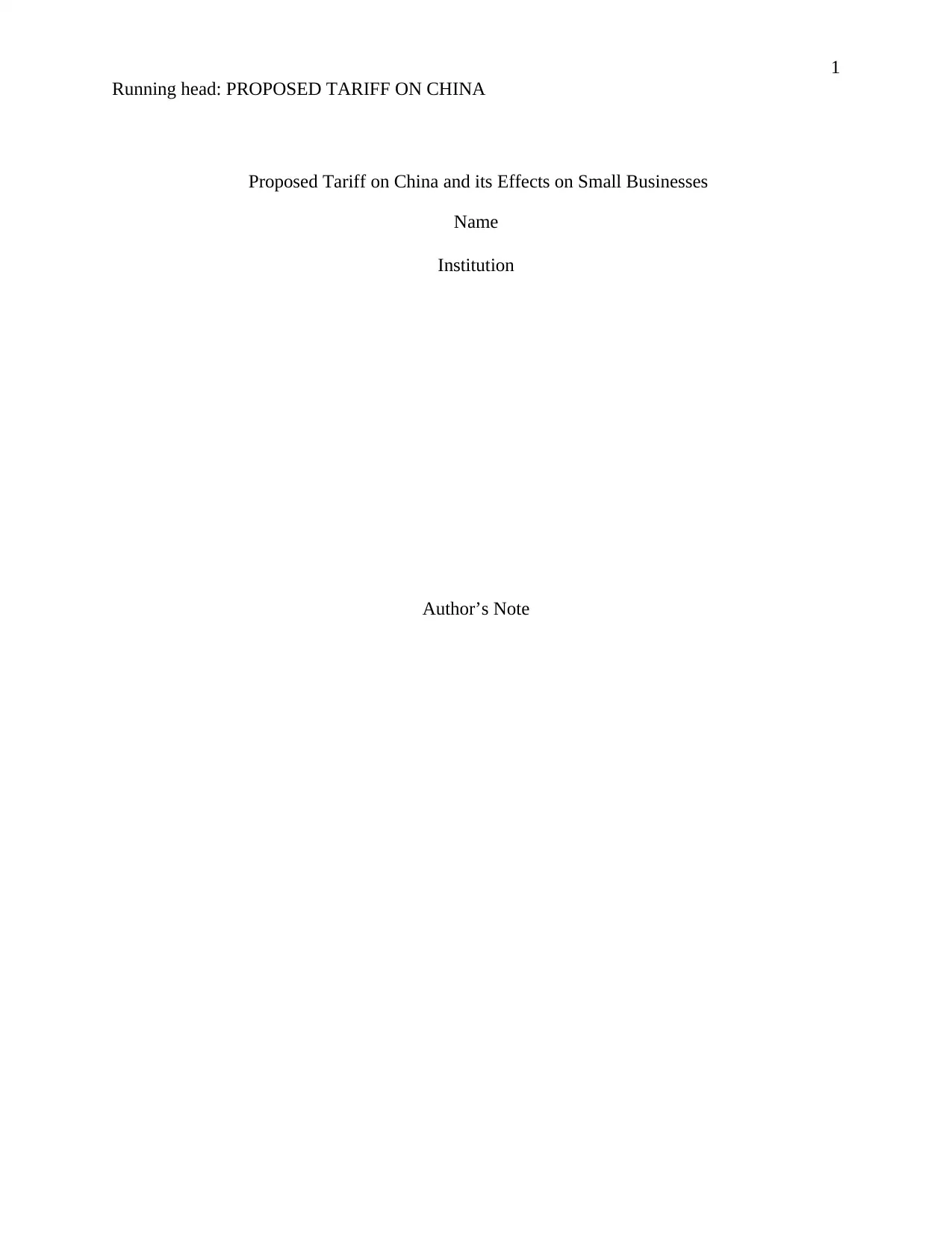
1
Running head: PROPOSED TARIFF ON CHINA
Proposed Tariff on China and its Effects on Small Businesses
Name
Institution
Author’s Note
Running head: PROPOSED TARIFF ON CHINA
Proposed Tariff on China and its Effects on Small Businesses
Name
Institution
Author’s Note
Paraphrase This Document
Need a fresh take? Get an instant paraphrase of this document with our AI Paraphraser
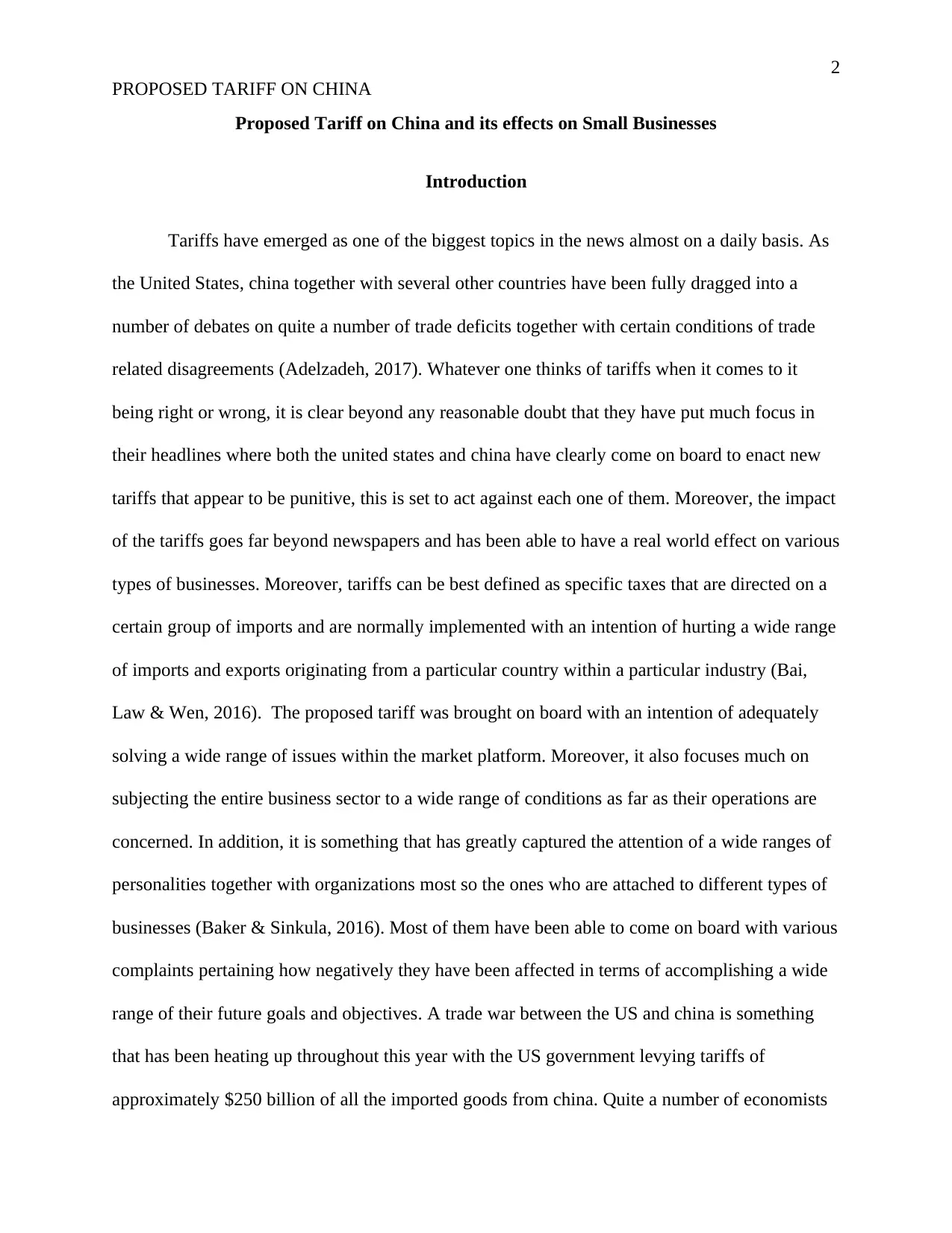
2
PROPOSED TARIFF ON CHINA
Proposed Tariff on China and its effects on Small Businesses
Introduction
Tariffs have emerged as one of the biggest topics in the news almost on a daily basis. As
the United States, china together with several other countries have been fully dragged into a
number of debates on quite a number of trade deficits together with certain conditions of trade
related disagreements (Adelzadeh, 2017). Whatever one thinks of tariffs when it comes to it
being right or wrong, it is clear beyond any reasonable doubt that they have put much focus in
their headlines where both the united states and china have clearly come on board to enact new
tariffs that appear to be punitive, this is set to act against each one of them. Moreover, the impact
of the tariffs goes far beyond newspapers and has been able to have a real world effect on various
types of businesses. Moreover, tariffs can be best defined as specific taxes that are directed on a
certain group of imports and are normally implemented with an intention of hurting a wide range
of imports and exports originating from a particular country within a particular industry (Bai,
Law & Wen, 2016). The proposed tariff was brought on board with an intention of adequately
solving a wide range of issues within the market platform. Moreover, it also focuses much on
subjecting the entire business sector to a wide range of conditions as far as their operations are
concerned. In addition, it is something that has greatly captured the attention of a wide ranges of
personalities together with organizations most so the ones who are attached to different types of
businesses (Baker & Sinkula, 2016). Most of them have been able to come on board with various
complaints pertaining how negatively they have been affected in terms of accomplishing a wide
range of their future goals and objectives. A trade war between the US and china is something
that has been heating up throughout this year with the US government levying tariffs of
approximately $250 billion of all the imported goods from china. Quite a number of economists
PROPOSED TARIFF ON CHINA
Proposed Tariff on China and its effects on Small Businesses
Introduction
Tariffs have emerged as one of the biggest topics in the news almost on a daily basis. As
the United States, china together with several other countries have been fully dragged into a
number of debates on quite a number of trade deficits together with certain conditions of trade
related disagreements (Adelzadeh, 2017). Whatever one thinks of tariffs when it comes to it
being right or wrong, it is clear beyond any reasonable doubt that they have put much focus in
their headlines where both the united states and china have clearly come on board to enact new
tariffs that appear to be punitive, this is set to act against each one of them. Moreover, the impact
of the tariffs goes far beyond newspapers and has been able to have a real world effect on various
types of businesses. Moreover, tariffs can be best defined as specific taxes that are directed on a
certain group of imports and are normally implemented with an intention of hurting a wide range
of imports and exports originating from a particular country within a particular industry (Bai,
Law & Wen, 2016). The proposed tariff was brought on board with an intention of adequately
solving a wide range of issues within the market platform. Moreover, it also focuses much on
subjecting the entire business sector to a wide range of conditions as far as their operations are
concerned. In addition, it is something that has greatly captured the attention of a wide ranges of
personalities together with organizations most so the ones who are attached to different types of
businesses (Baker & Sinkula, 2016). Most of them have been able to come on board with various
complaints pertaining how negatively they have been affected in terms of accomplishing a wide
range of their future goals and objectives. A trade war between the US and china is something
that has been heating up throughout this year with the US government levying tariffs of
approximately $250 billion of all the imported goods from china. Quite a number of economists
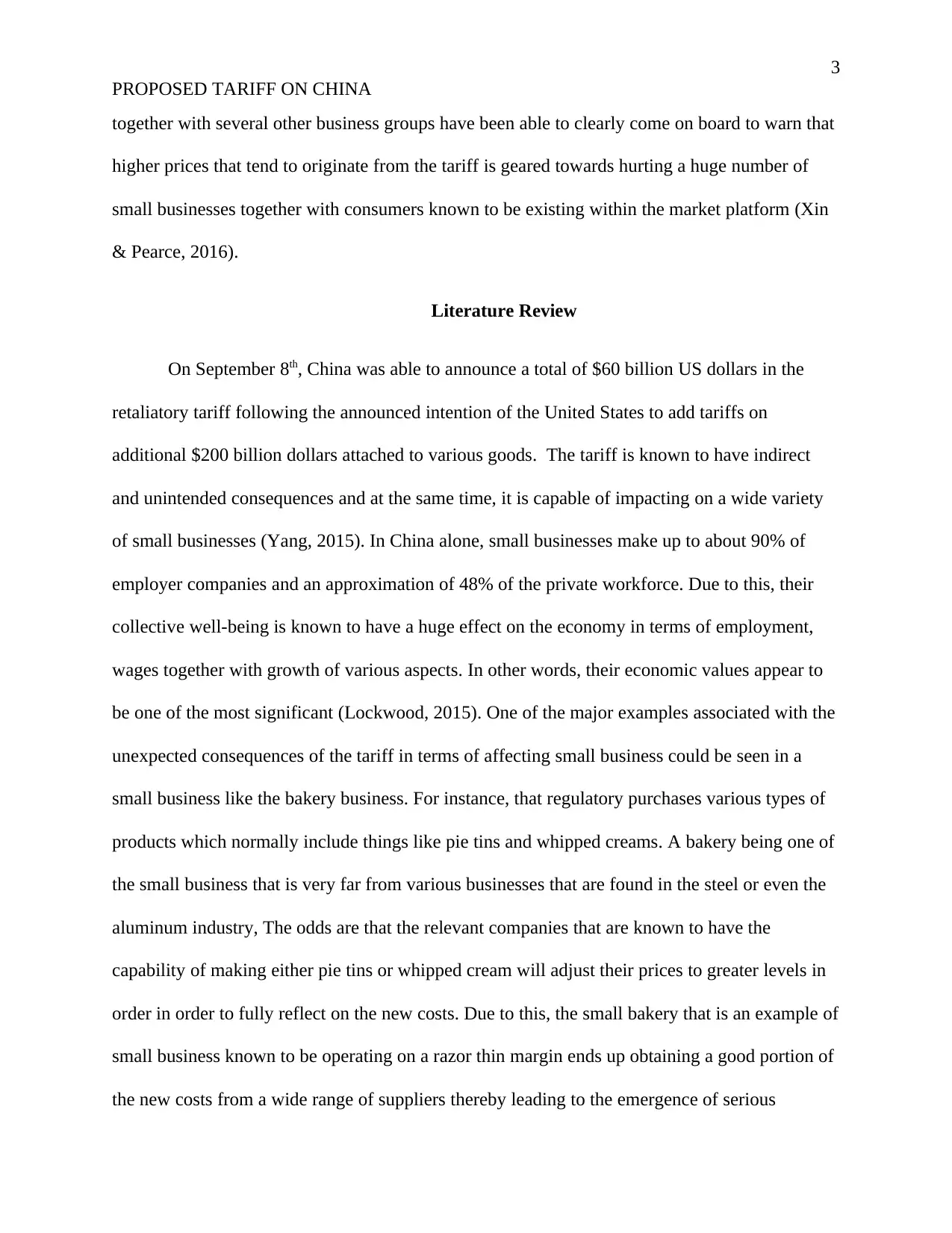
3
PROPOSED TARIFF ON CHINA
together with several other business groups have been able to clearly come on board to warn that
higher prices that tend to originate from the tariff is geared towards hurting a huge number of
small businesses together with consumers known to be existing within the market platform (Xin
& Pearce, 2016).
Literature Review
On September 8th, China was able to announce a total of $60 billion US dollars in the
retaliatory tariff following the announced intention of the United States to add tariffs on
additional $200 billion dollars attached to various goods. The tariff is known to have indirect
and unintended consequences and at the same time, it is capable of impacting on a wide variety
of small businesses (Yang, 2015). In China alone, small businesses make up to about 90% of
employer companies and an approximation of 48% of the private workforce. Due to this, their
collective well-being is known to have a huge effect on the economy in terms of employment,
wages together with growth of various aspects. In other words, their economic values appear to
be one of the most significant (Lockwood, 2015). One of the major examples associated with the
unexpected consequences of the tariff in terms of affecting small business could be seen in a
small business like the bakery business. For instance, that regulatory purchases various types of
products which normally include things like pie tins and whipped creams. A bakery being one of
the small business that is very far from various businesses that are found in the steel or even the
aluminum industry, The odds are that the relevant companies that are known to have the
capability of making either pie tins or whipped cream will adjust their prices to greater levels in
order in order to fully reflect on the new costs. Due to this, the small bakery that is an example of
small business known to be operating on a razor thin margin ends up obtaining a good portion of
the new costs from a wide range of suppliers thereby leading to the emergence of serious
PROPOSED TARIFF ON CHINA
together with several other business groups have been able to clearly come on board to warn that
higher prices that tend to originate from the tariff is geared towards hurting a huge number of
small businesses together with consumers known to be existing within the market platform (Xin
& Pearce, 2016).
Literature Review
On September 8th, China was able to announce a total of $60 billion US dollars in the
retaliatory tariff following the announced intention of the United States to add tariffs on
additional $200 billion dollars attached to various goods. The tariff is known to have indirect
and unintended consequences and at the same time, it is capable of impacting on a wide variety
of small businesses (Yang, 2015). In China alone, small businesses make up to about 90% of
employer companies and an approximation of 48% of the private workforce. Due to this, their
collective well-being is known to have a huge effect on the economy in terms of employment,
wages together with growth of various aspects. In other words, their economic values appear to
be one of the most significant (Lockwood, 2015). One of the major examples associated with the
unexpected consequences of the tariff in terms of affecting small business could be seen in a
small business like the bakery business. For instance, that regulatory purchases various types of
products which normally include things like pie tins and whipped creams. A bakery being one of
the small business that is very far from various businesses that are found in the steel or even the
aluminum industry, The odds are that the relevant companies that are known to have the
capability of making either pie tins or whipped cream will adjust their prices to greater levels in
order in order to fully reflect on the new costs. Due to this, the small bakery that is an example of
small business known to be operating on a razor thin margin ends up obtaining a good portion of
the new costs from a wide range of suppliers thereby leading to the emergence of serious
⊘ This is a preview!⊘
Do you want full access?
Subscribe today to unlock all pages.

Trusted by 1+ million students worldwide
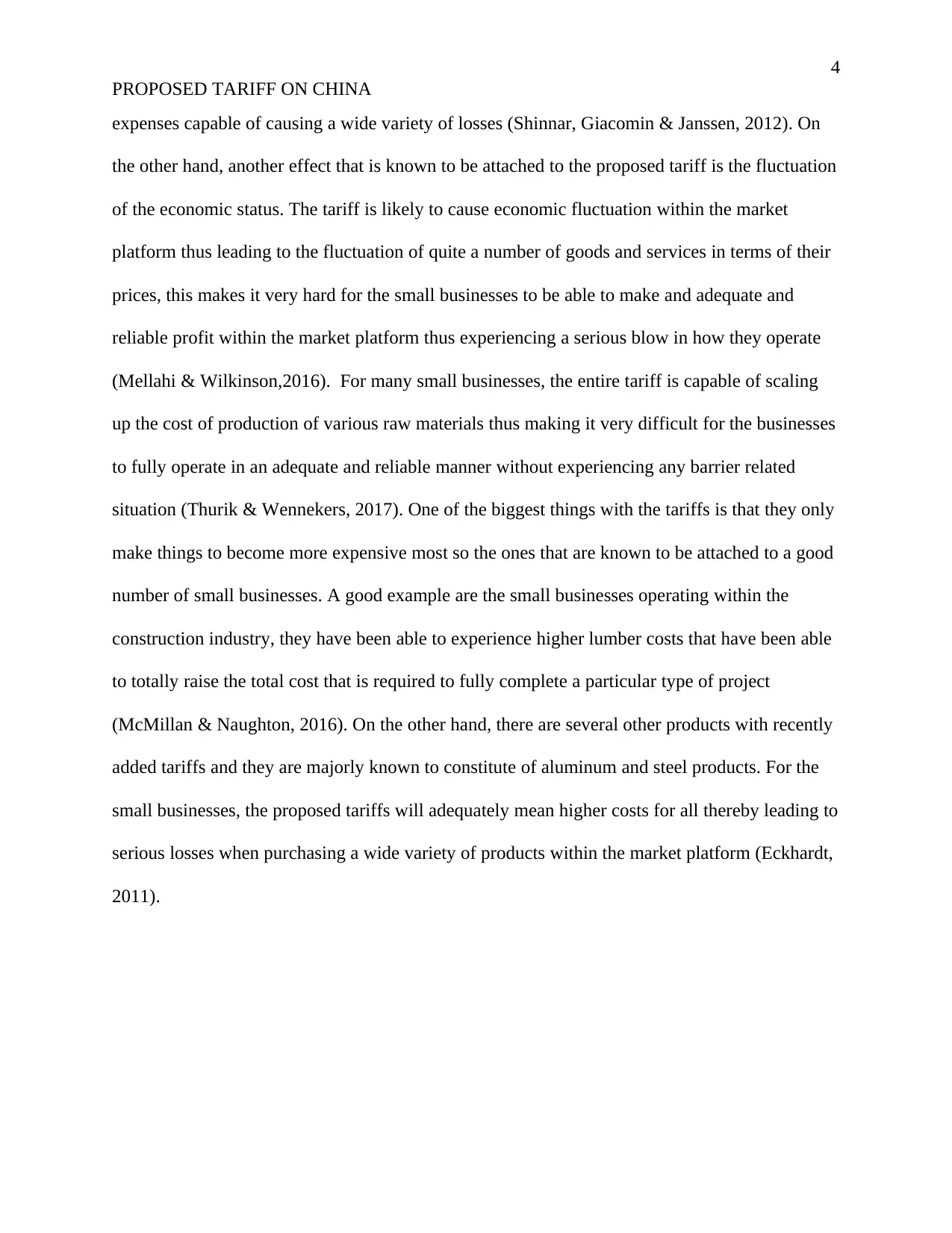
4
PROPOSED TARIFF ON CHINA
expenses capable of causing a wide variety of losses (Shinnar, Giacomin & Janssen, 2012). On
the other hand, another effect that is known to be attached to the proposed tariff is the fluctuation
of the economic status. The tariff is likely to cause economic fluctuation within the market
platform thus leading to the fluctuation of quite a number of goods and services in terms of their
prices, this makes it very hard for the small businesses to be able to make and adequate and
reliable profit within the market platform thus experiencing a serious blow in how they operate
(Mellahi & Wilkinson,2016). For many small businesses, the entire tariff is capable of scaling
up the cost of production of various raw materials thus making it very difficult for the businesses
to fully operate in an adequate and reliable manner without experiencing any barrier related
situation (Thurik & Wennekers, 2017). One of the biggest things with the tariffs is that they only
make things to become more expensive most so the ones that are known to be attached to a good
number of small businesses. A good example are the small businesses operating within the
construction industry, they have been able to experience higher lumber costs that have been able
to totally raise the total cost that is required to fully complete a particular type of project
(McMillan & Naughton, 2016). On the other hand, there are several other products with recently
added tariffs and they are majorly known to constitute of aluminum and steel products. For the
small businesses, the proposed tariffs will adequately mean higher costs for all thereby leading to
serious losses when purchasing a wide variety of products within the market platform (Eckhardt,
2011).
PROPOSED TARIFF ON CHINA
expenses capable of causing a wide variety of losses (Shinnar, Giacomin & Janssen, 2012). On
the other hand, another effect that is known to be attached to the proposed tariff is the fluctuation
of the economic status. The tariff is likely to cause economic fluctuation within the market
platform thus leading to the fluctuation of quite a number of goods and services in terms of their
prices, this makes it very hard for the small businesses to be able to make and adequate and
reliable profit within the market platform thus experiencing a serious blow in how they operate
(Mellahi & Wilkinson,2016). For many small businesses, the entire tariff is capable of scaling
up the cost of production of various raw materials thus making it very difficult for the businesses
to fully operate in an adequate and reliable manner without experiencing any barrier related
situation (Thurik & Wennekers, 2017). One of the biggest things with the tariffs is that they only
make things to become more expensive most so the ones that are known to be attached to a good
number of small businesses. A good example are the small businesses operating within the
construction industry, they have been able to experience higher lumber costs that have been able
to totally raise the total cost that is required to fully complete a particular type of project
(McMillan & Naughton, 2016). On the other hand, there are several other products with recently
added tariffs and they are majorly known to constitute of aluminum and steel products. For the
small businesses, the proposed tariffs will adequately mean higher costs for all thereby leading to
serious losses when purchasing a wide variety of products within the market platform (Eckhardt,
2011).
Paraphrase This Document
Need a fresh take? Get an instant paraphrase of this document with our AI Paraphraser
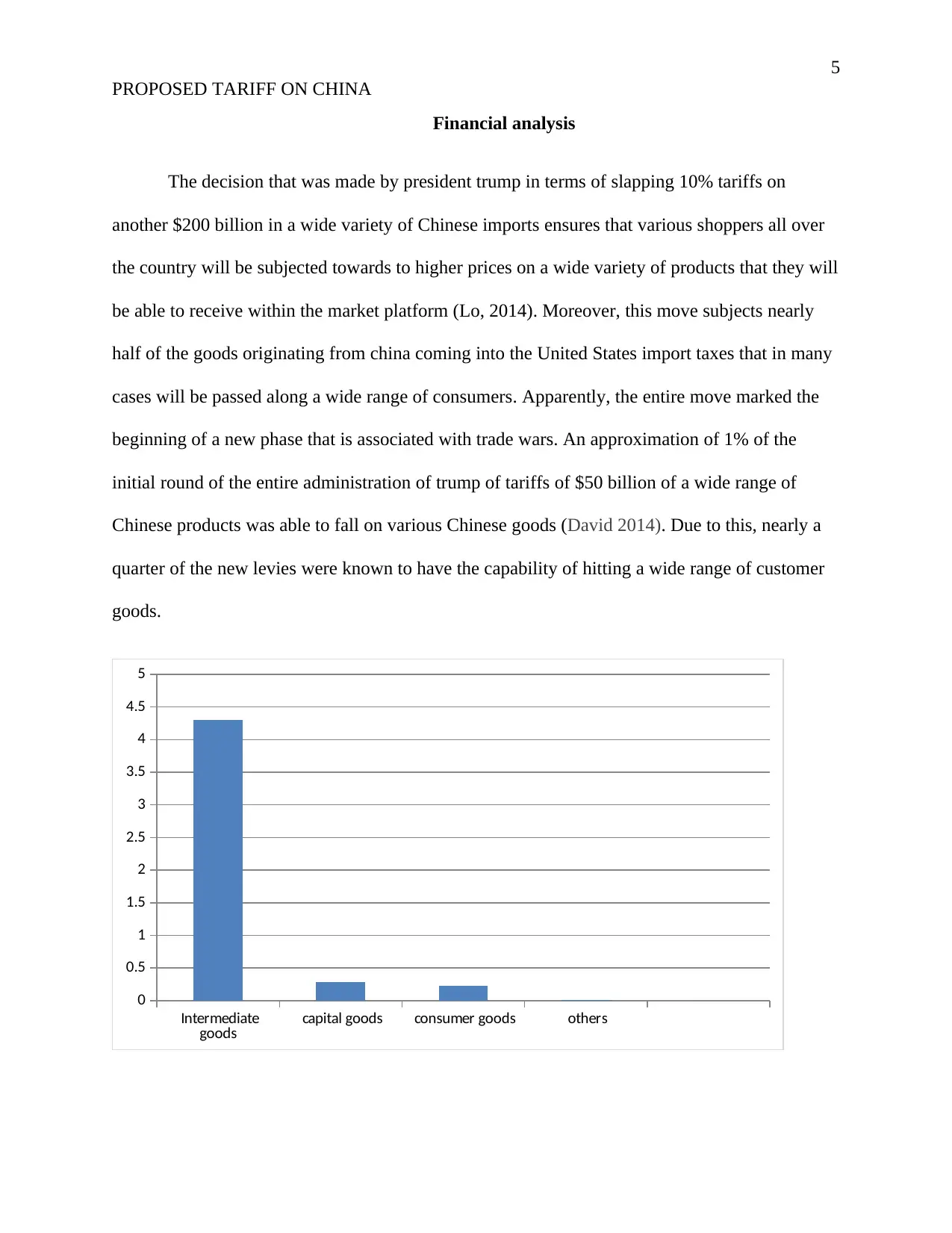
5
PROPOSED TARIFF ON CHINA
Financial analysis
The decision that was made by president trump in terms of slapping 10% tariffs on
another $200 billion in a wide variety of Chinese imports ensures that various shoppers all over
the country will be subjected towards to higher prices on a wide variety of products that they will
be able to receive within the market platform (Lo, 2014). Moreover, this move subjects nearly
half of the goods originating from china coming into the United States import taxes that in many
cases will be passed along a wide range of consumers. Apparently, the entire move marked the
beginning of a new phase that is associated with trade wars. An approximation of 1% of the
initial round of the entire administration of trump of tariffs of $50 billion of a wide range of
Chinese products was able to fall on various Chinese goods (David 2014). Due to this, nearly a
quarter of the new levies were known to have the capability of hitting a wide range of customer
goods.
Intermediate
goods capital goods consumer goods others
0
0.5
1
1.5
2
2.5
3
3.5
4
4.5
5
PROPOSED TARIFF ON CHINA
Financial analysis
The decision that was made by president trump in terms of slapping 10% tariffs on
another $200 billion in a wide variety of Chinese imports ensures that various shoppers all over
the country will be subjected towards to higher prices on a wide variety of products that they will
be able to receive within the market platform (Lo, 2014). Moreover, this move subjects nearly
half of the goods originating from china coming into the United States import taxes that in many
cases will be passed along a wide range of consumers. Apparently, the entire move marked the
beginning of a new phase that is associated with trade wars. An approximation of 1% of the
initial round of the entire administration of trump of tariffs of $50 billion of a wide range of
Chinese products was able to fall on various Chinese goods (David 2014). Due to this, nearly a
quarter of the new levies were known to have the capability of hitting a wide range of customer
goods.
Intermediate
goods capital goods consumer goods others
0
0.5
1
1.5
2
2.5
3
3.5
4
4.5
5
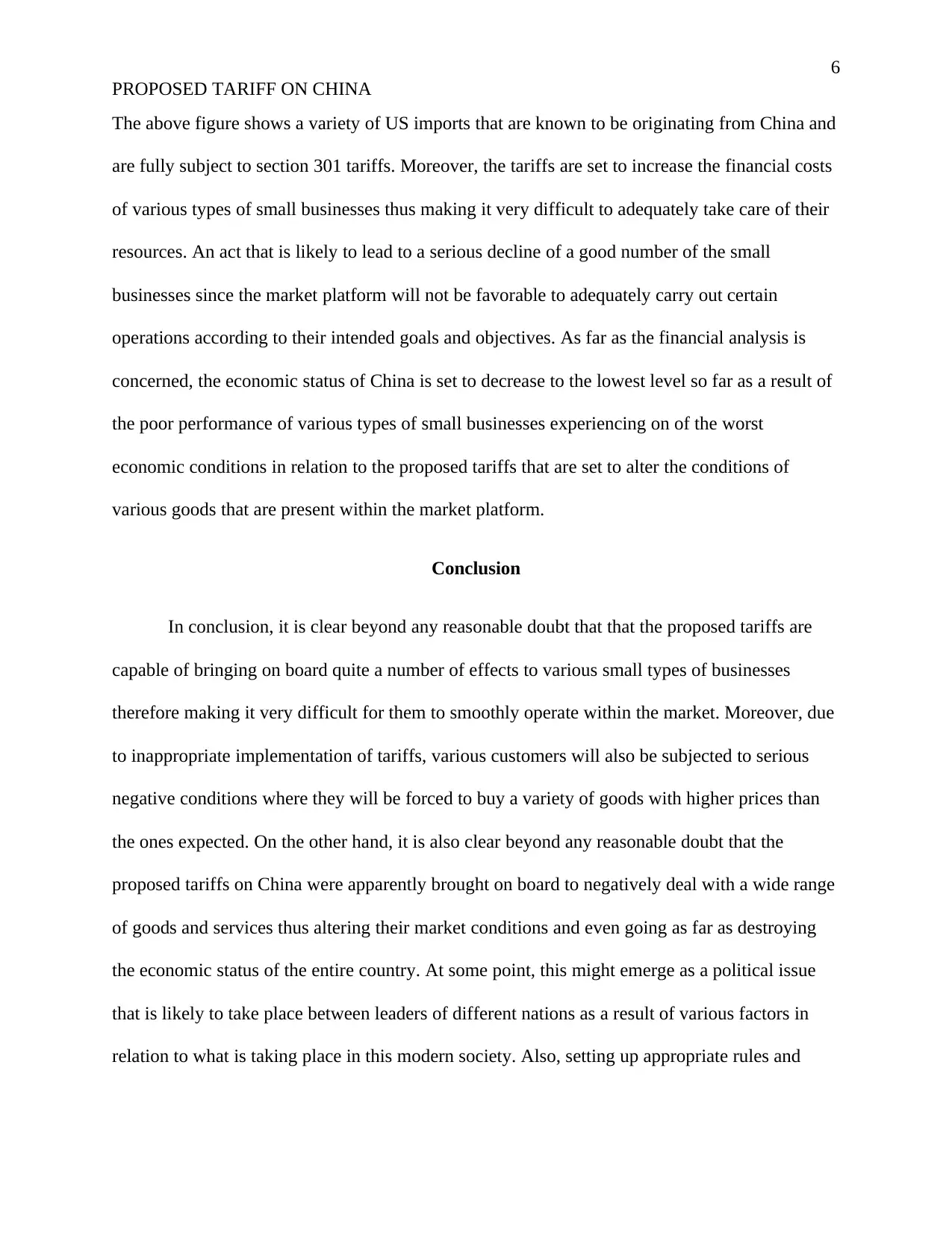
6
PROPOSED TARIFF ON CHINA
The above figure shows a variety of US imports that are known to be originating from China and
are fully subject to section 301 tariffs. Moreover, the tariffs are set to increase the financial costs
of various types of small businesses thus making it very difficult to adequately take care of their
resources. An act that is likely to lead to a serious decline of a good number of the small
businesses since the market platform will not be favorable to adequately carry out certain
operations according to their intended goals and objectives. As far as the financial analysis is
concerned, the economic status of China is set to decrease to the lowest level so far as a result of
the poor performance of various types of small businesses experiencing on of the worst
economic conditions in relation to the proposed tariffs that are set to alter the conditions of
various goods that are present within the market platform.
Conclusion
In conclusion, it is clear beyond any reasonable doubt that that the proposed tariffs are
capable of bringing on board quite a number of effects to various small types of businesses
therefore making it very difficult for them to smoothly operate within the market. Moreover, due
to inappropriate implementation of tariffs, various customers will also be subjected to serious
negative conditions where they will be forced to buy a variety of goods with higher prices than
the ones expected. On the other hand, it is also clear beyond any reasonable doubt that the
proposed tariffs on China were apparently brought on board to negatively deal with a wide range
of goods and services thus altering their market conditions and even going as far as destroying
the economic status of the entire country. At some point, this might emerge as a political issue
that is likely to take place between leaders of different nations as a result of various factors in
relation to what is taking place in this modern society. Also, setting up appropriate rules and
PROPOSED TARIFF ON CHINA
The above figure shows a variety of US imports that are known to be originating from China and
are fully subject to section 301 tariffs. Moreover, the tariffs are set to increase the financial costs
of various types of small businesses thus making it very difficult to adequately take care of their
resources. An act that is likely to lead to a serious decline of a good number of the small
businesses since the market platform will not be favorable to adequately carry out certain
operations according to their intended goals and objectives. As far as the financial analysis is
concerned, the economic status of China is set to decrease to the lowest level so far as a result of
the poor performance of various types of small businesses experiencing on of the worst
economic conditions in relation to the proposed tariffs that are set to alter the conditions of
various goods that are present within the market platform.
Conclusion
In conclusion, it is clear beyond any reasonable doubt that that the proposed tariffs are
capable of bringing on board quite a number of effects to various small types of businesses
therefore making it very difficult for them to smoothly operate within the market. Moreover, due
to inappropriate implementation of tariffs, various customers will also be subjected to serious
negative conditions where they will be forced to buy a variety of goods with higher prices than
the ones expected. On the other hand, it is also clear beyond any reasonable doubt that the
proposed tariffs on China were apparently brought on board to negatively deal with a wide range
of goods and services thus altering their market conditions and even going as far as destroying
the economic status of the entire country. At some point, this might emerge as a political issue
that is likely to take place between leaders of different nations as a result of various factors in
relation to what is taking place in this modern society. Also, setting up appropriate rules and
⊘ This is a preview!⊘
Do you want full access?
Subscribe today to unlock all pages.

Trusted by 1+ million students worldwide
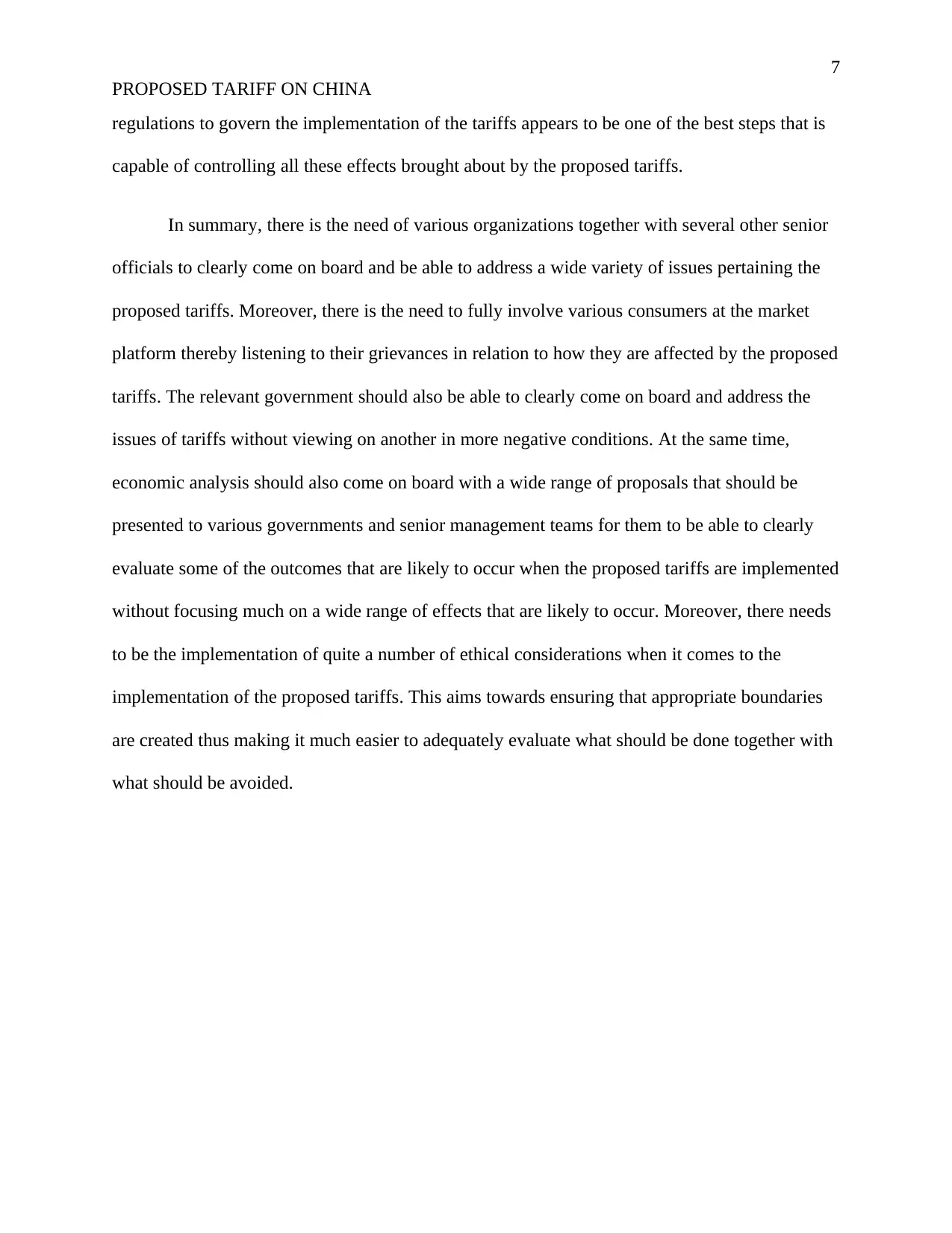
7
PROPOSED TARIFF ON CHINA
regulations to govern the implementation of the tariffs appears to be one of the best steps that is
capable of controlling all these effects brought about by the proposed tariffs.
In summary, there is the need of various organizations together with several other senior
officials to clearly come on board and be able to address a wide variety of issues pertaining the
proposed tariffs. Moreover, there is the need to fully involve various consumers at the market
platform thereby listening to their grievances in relation to how they are affected by the proposed
tariffs. The relevant government should also be able to clearly come on board and address the
issues of tariffs without viewing on another in more negative conditions. At the same time,
economic analysis should also come on board with a wide range of proposals that should be
presented to various governments and senior management teams for them to be able to clearly
evaluate some of the outcomes that are likely to occur when the proposed tariffs are implemented
without focusing much on a wide range of effects that are likely to occur. Moreover, there needs
to be the implementation of quite a number of ethical considerations when it comes to the
implementation of the proposed tariffs. This aims towards ensuring that appropriate boundaries
are created thus making it much easier to adequately evaluate what should be done together with
what should be avoided.
PROPOSED TARIFF ON CHINA
regulations to govern the implementation of the tariffs appears to be one of the best steps that is
capable of controlling all these effects brought about by the proposed tariffs.
In summary, there is the need of various organizations together with several other senior
officials to clearly come on board and be able to address a wide variety of issues pertaining the
proposed tariffs. Moreover, there is the need to fully involve various consumers at the market
platform thereby listening to their grievances in relation to how they are affected by the proposed
tariffs. The relevant government should also be able to clearly come on board and address the
issues of tariffs without viewing on another in more negative conditions. At the same time,
economic analysis should also come on board with a wide range of proposals that should be
presented to various governments and senior management teams for them to be able to clearly
evaluate some of the outcomes that are likely to occur when the proposed tariffs are implemented
without focusing much on a wide range of effects that are likely to occur. Moreover, there needs
to be the implementation of quite a number of ethical considerations when it comes to the
implementation of the proposed tariffs. This aims towards ensuring that appropriate boundaries
are created thus making it much easier to adequately evaluate what should be done together with
what should be avoided.
Paraphrase This Document
Need a fresh take? Get an instant paraphrase of this document with our AI Paraphraser
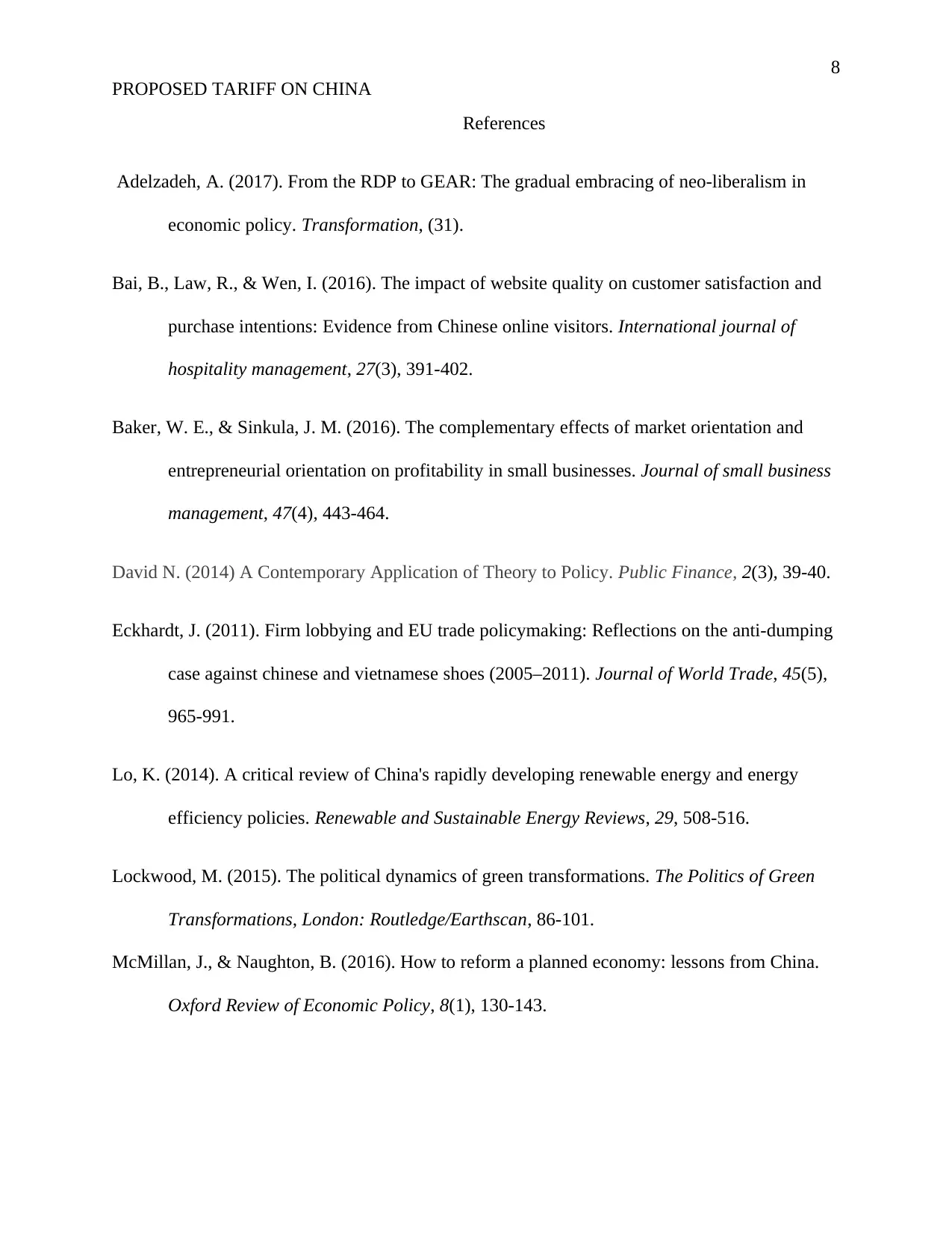
8
PROPOSED TARIFF ON CHINA
References
Adelzadeh, A. (2017). From the RDP to GEAR: The gradual embracing of neo-liberalism in
economic policy. Transformation, (31).
Bai, B., Law, R., & Wen, I. (2016). The impact of website quality on customer satisfaction and
purchase intentions: Evidence from Chinese online visitors. International journal of
hospitality management, 27(3), 391-402.
Baker, W. E., & Sinkula, J. M. (2016). The complementary effects of market orientation and
entrepreneurial orientation on profitability in small businesses. Journal of small business
management, 47(4), 443-464.
David N. (2014) A Contemporary Application of Theory to Policy. Public Finance, 2(3), 39-40.
Eckhardt, J. (2011). Firm lobbying and EU trade policymaking: Reflections on the anti-dumping
case against chinese and vietnamese shoes (2005–2011). Journal of World Trade, 45(5),
965-991.
Lo, K. (2014). A critical review of China's rapidly developing renewable energy and energy
efficiency policies. Renewable and Sustainable Energy Reviews, 29, 508-516.
Lockwood, M. (2015). The political dynamics of green transformations. The Politics of Green
Transformations, London: Routledge/Earthscan, 86-101.
McMillan, J., & Naughton, B. (2016). How to reform a planned economy: lessons from China.
Oxford Review of Economic Policy, 8(1), 130-143.
PROPOSED TARIFF ON CHINA
References
Adelzadeh, A. (2017). From the RDP to GEAR: The gradual embracing of neo-liberalism in
economic policy. Transformation, (31).
Bai, B., Law, R., & Wen, I. (2016). The impact of website quality on customer satisfaction and
purchase intentions: Evidence from Chinese online visitors. International journal of
hospitality management, 27(3), 391-402.
Baker, W. E., & Sinkula, J. M. (2016). The complementary effects of market orientation and
entrepreneurial orientation on profitability in small businesses. Journal of small business
management, 47(4), 443-464.
David N. (2014) A Contemporary Application of Theory to Policy. Public Finance, 2(3), 39-40.
Eckhardt, J. (2011). Firm lobbying and EU trade policymaking: Reflections on the anti-dumping
case against chinese and vietnamese shoes (2005–2011). Journal of World Trade, 45(5),
965-991.
Lo, K. (2014). A critical review of China's rapidly developing renewable energy and energy
efficiency policies. Renewable and Sustainable Energy Reviews, 29, 508-516.
Lockwood, M. (2015). The political dynamics of green transformations. The Politics of Green
Transformations, London: Routledge/Earthscan, 86-101.
McMillan, J., & Naughton, B. (2016). How to reform a planned economy: lessons from China.
Oxford Review of Economic Policy, 8(1), 130-143.
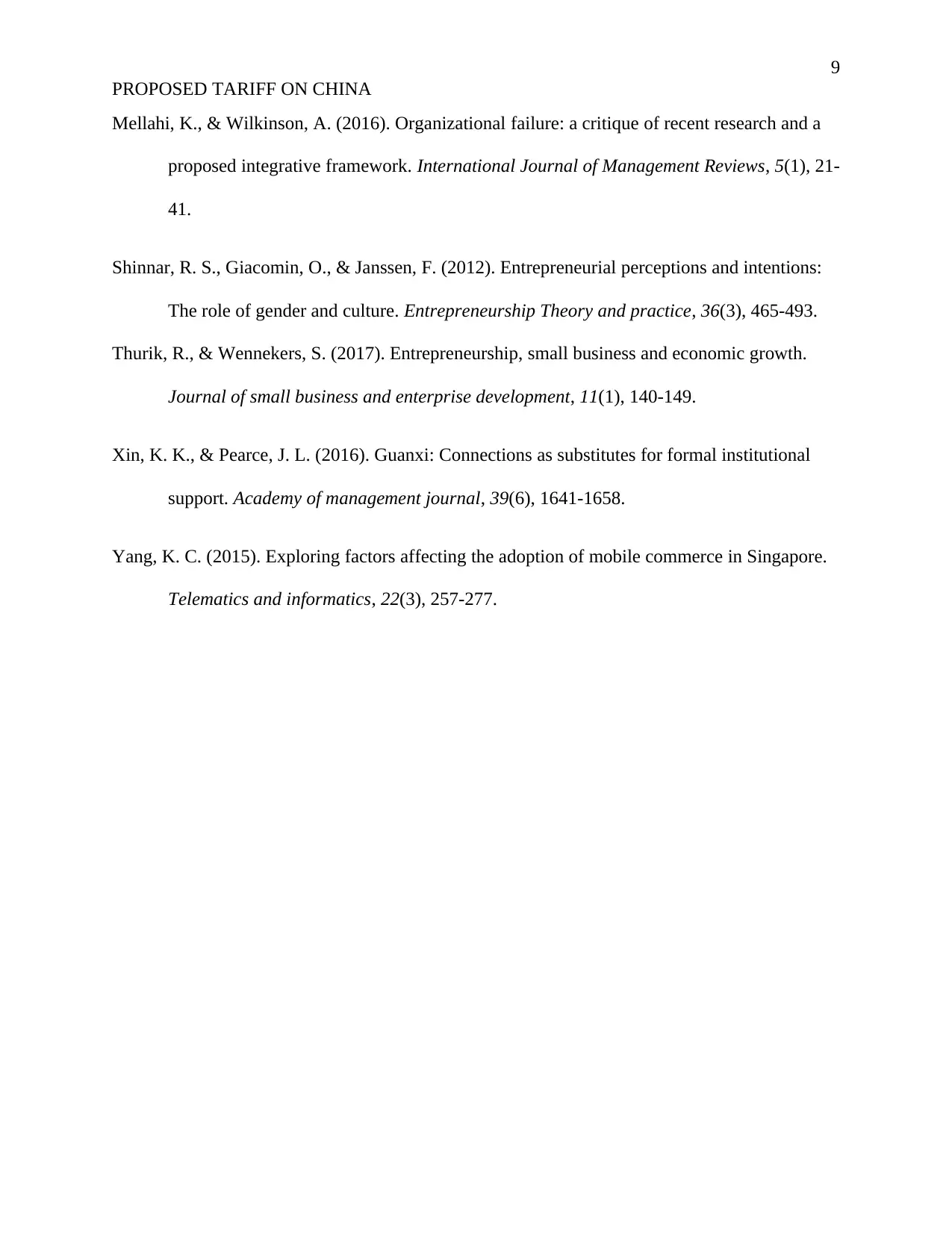
9
PROPOSED TARIFF ON CHINA
Mellahi, K., & Wilkinson, A. (2016). Organizational failure: a critique of recent research and a
proposed integrative framework. International Journal of Management Reviews, 5(1), 21-
41.
Shinnar, R. S., Giacomin, O., & Janssen, F. (2012). Entrepreneurial perceptions and intentions:
The role of gender and culture. Entrepreneurship Theory and practice, 36(3), 465-493.
Thurik, R., & Wennekers, S. (2017). Entrepreneurship, small business and economic growth.
Journal of small business and enterprise development, 11(1), 140-149.
Xin, K. K., & Pearce, J. L. (2016). Guanxi: Connections as substitutes for formal institutional
support. Academy of management journal, 39(6), 1641-1658.
Yang, K. C. (2015). Exploring factors affecting the adoption of mobile commerce in Singapore.
Telematics and informatics, 22(3), 257-277.
PROPOSED TARIFF ON CHINA
Mellahi, K., & Wilkinson, A. (2016). Organizational failure: a critique of recent research and a
proposed integrative framework. International Journal of Management Reviews, 5(1), 21-
41.
Shinnar, R. S., Giacomin, O., & Janssen, F. (2012). Entrepreneurial perceptions and intentions:
The role of gender and culture. Entrepreneurship Theory and practice, 36(3), 465-493.
Thurik, R., & Wennekers, S. (2017). Entrepreneurship, small business and economic growth.
Journal of small business and enterprise development, 11(1), 140-149.
Xin, K. K., & Pearce, J. L. (2016). Guanxi: Connections as substitutes for formal institutional
support. Academy of management journal, 39(6), 1641-1658.
Yang, K. C. (2015). Exploring factors affecting the adoption of mobile commerce in Singapore.
Telematics and informatics, 22(3), 257-277.
⊘ This is a preview!⊘
Do you want full access?
Subscribe today to unlock all pages.

Trusted by 1+ million students worldwide
1 out of 9
Related Documents
Your All-in-One AI-Powered Toolkit for Academic Success.
+13062052269
info@desklib.com
Available 24*7 on WhatsApp / Email
![[object Object]](/_next/static/media/star-bottom.7253800d.svg)
Unlock your academic potential
Copyright © 2020–2025 A2Z Services. All Rights Reserved. Developed and managed by ZUCOL.





